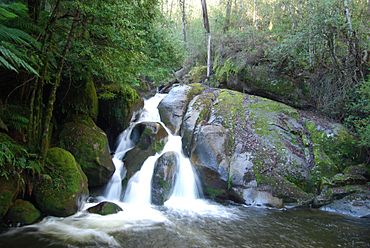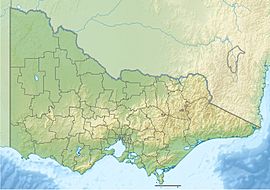Yarra Ranges National Park facts for kids
Quick facts for kids Yarra Ranges National ParkVictoria |
|
|---|---|
|
IUCN Category II (National Park)
|
|

A waterfall in the national park near Marysville
|
|
| Nearest town or city | Melbourne |
| Established | December 1995 |
| Area | 760 km2 (293.4 sq mi) |
| Visitation | 800,000 (in 2002) |
| Managing authorities | Parks Victoria |
| Website | Yarra Ranges National Park |
| See also | Protected areas of Victoria |
The Yarra Ranges National Park is a special place in southeastern Australia. It is located in the Victoria Central Highlands, about 107 kilometres northeast of Melbourne.
This park was created in 1995 and is looked after by Parks Victoria. It has amazing forests with some of the tallest trees in the world, called Mountain Ash trees. These trees are super important because they store a lot of carbon, which helps fight climate change.
The park covers a huge area of 76,003 hectares. Many different animals live here, like kangaroos, wallabies, wombats, platypuses, and over 120 kinds of native birds. The Yarra, O'Shaunessy, and Taggerty rivers flow through the park. These rivers and several big reservoirs provide a lot of the drinking water for Melbourne.
Like many natural areas, Yarra Ranges National Park faces challenges. These include changes in climate and plants that invade the park and harm native species.
Contents
About Yarra Ranges National Park
The Yarra Ranges National Park was officially opened in December 1995. It stretches across 76,003 hectares in Victoria's Central Highlands. This park is recognized internationally as an "IUCN Category 2" protected area. This means it is mainly managed to protect its amazing nature and allow people to enjoy it responsibly.
The park is home to two main types of forests. One is the wet Mountain Ash Forest. The other is a cool Temperate Rainforest. Both are filled with many different kinds of plants and animals.
Mount Donna Buang is the park's biggest mountain. It stands 1,245 meters tall above the town of Warburton. The park also includes the starting points of the Yarra, O'Shannassy, and Taggerty Rivers. These rivers feed into important dams and reservoirs. In fact, 70% of Melbourne's drinking water comes from this park!
Most of the park (84%) is part of a special "Designated Water Supply Catchment Area." This area is managed under a "Closed Catchment Policy." This means that some parts of the park have limited public access. This rule helps protect Melbourne's important water supply.
Amazing Plants and Animals
The Yarra Ranges National Park is famous for its incredible Mountain Ash trees. These trees are among the tallest in the world. They are also the tallest flowering plants on Earth!
Mountain Ash trees can live for 400 years. They often grow up to 90 meters tall. The tallest one ever recorded was the "Ferguson Tree," found in 1872. It was over 154 meters high! These trees grow very close together. They have the most "biomass" (living material) of any trees in the world. This means they are excellent at soaking up and storing carbon dioxide from the air. A study in 2009 found that Mountain Ash forests are the best at storing carbon. They can hold 1,867 tonnes of carbon per hectare.
Even when these giant trees die, they are still important. Their dead stumps and fallen logs become homes for at least 40 types of animals. These animals need tree hollows to live. One very special animal is the endangered Leadbeater's Possum. This small possum is Victoria's animal symbol! Other animals that live in these hollows include the Mountain Brushtail Possum and the Greater Glider. You can also find nine types of small plants called "epiphytes" growing on Mountain Ash trees. The most common one is Liverwort. The park also protects other rare plants, like the Slender Tree Fern.
The park is a safe home for many native animals. Over 120 different kinds of native birds have been seen here. Some of these include the Pink Robin, Yellow-tailed black cockatoo, Australian King Parrot, and the Grey Goshawk. Three types of rare owls also live in the park: the Sooty Owl, Powerful Owl, and the Barking Owl.
You can often spot native mammals like Kangaroos, Wallabies, and Wombats in the park. The rivers and streams are full of Platypuses. Many fish species also swim in the water, such as Redfin perch, European carp, and Golden perch. If you look closely at insects, you might find a rare one called the Mount Donna Buang Wingless Stonefly. This insect is only found on Mount Donna Buang!
Threats to the Park
Invasive Plants and Animals
One of the biggest problems for Yarra Ranges National Park is invasive weeds. These are plants that are not native to the park. They spread quickly and take over, harming the native plants. There are about 200 types of weeds in the park, many of which come from nearby gardens.
Some of the most harmful weeds are:
- Weeds of National Significance (WONS): These are plants that cause big problems across Australia. In the park, these include Willows, Blackberry, Boneseed, and Bridal Creeper.
- Native species as weeds: Sometimes, even Australian native plants can become weeds if they grow in the wrong place. Examples in the park are Bluebell Creeper, Cedar Wattle, and Cootamundra Wattle.
- Declared Noxious Weeds: These plants are officially listed as harmful. They must be controlled because they can seriously damage the environment. Ragwort, Spear Thistle, and Hawthorn are some examples.
Invasive animals also cause problems. They hunt native wildlife and compete for food, water, and homes. Red foxes are a common pest animal in Victoria. To control them, the park sometimes allows hunters in. Other pest animals in the park include European Rabbits and feral cats.
Bushfires
Fires are a natural part of the Australian environment. They can help some ecosystems renew themselves. However, recently, bushfires have been happening too often, too strongly, or at the wrong times of the year. This makes it hard for plants and animals to recover.
To reduce the risk of big fires, Parks Victoria and the Department of Environment, Land, Water and Planning (DELWP) do "controlled burns." These are small, planned fires that burn off dead wood, leaves, and other fuel that could easily catch fire in summer. By reducing this fuel, controlled burns help make future bushfires less intense and damaging.
Climate Change Effects
Climate change is affecting all natural areas in Australia, including Yarra Ranges National Park. As temperatures rise, the amount of rain often decreases. This means less water flows in the rivers and streams. Less water can lower the quality of drinking water for Melbourne. It also impacts the plants and animals that rely on the park's waterways.
Scientists predict that the park's average temperature will increase. Wind speeds are also expected to rise. These changes will affect the park's ecosystem and how it works.
Park History
The Yarra Ranges area has very thick forests. Because of this, it was not a main living area for Aboriginal people. European settlers also found it hard to get into the area at first.
The area was settled around 1860. People soon realized it was a great place for timber. Later, it was seen as important for collecting water. This led to the building of the Maroondah and Upper Yarra dams.
How the Park is Managed
Yarra Ranges National Park is managed by Parks Victoria, the Department of Environment, Land, Water and Planning (DELWP), and Melbourne Water. In 2002, Parks Victoria created a plan to guide how the park is managed. These plans are still used today.
Parks Victoria works to protect the park's important natural areas by:
- Protecting old-growth forests and special plants: They want to learn more about the park's plants through surveys and research. This helps them create better ways to protect rare species. They also actively fight against threats like weed invasions.
- Protecting native animals and their variety: They work to keep animal homes safe by controlling pest plants and animals. They also encourage surveys of animals, especially endangered ones. This helps make sure these species continue to live well in the park. They also tell visitors not to feed wildlife.
- Managing fires: Parks Victoria sometimes allows local people to collect dead wood from the park. This helps reduce the amount of fuel that could cause big fires.
They also focus on protecting the water resources by:
- Keeping access limited: They continue the "Restricted Access Policy" for the water supply areas. This stops people from bringing pets or leaving rubbish that could pollute the water.
- Protecting from wildfires: They follow a special plan to protect the water supply areas from bushfires.
- Watching roads and traffic: They check how roads and traffic affect the water supply. This helps prevent soil from washing into the water.
Is the Management Working?
The current rules for the "Restricted Access Policy" are good at protecting the park's water. By limiting how many people can enter the water supply areas, it helps keep the water clean. This is important for the drinking water supplied to Melbourne. Also, the rule about not feeding wildlife helps native animals stay wild and healthy.
However, the number of Mountain Ash trees has gone down. This is due to climate change, bushfires, and logging near the park. While climate change is hard to stop, big fire damage can be reduced. More planned burns could help remove fuel and make fires less severe. Also, stopping logging close to the park would help protect these important forests. A new rule could prevent logging within 20 kilometres of the park.
When Mountain Ash trees disappear, animals lose their homes. This is a big worry for the Leadbeater's Possum and other endangered animals. Parks Victoria and DELWP have plans to protect these animals from pests and human contact. But there are no specific plans to fight the growing threat of climate change.
Some zoos, like Healesville Sanctuary, have breeding programs for endangered animals. Once these animals are old enough, they are released into the park. This helps increase their numbers. However, the park's "open wood days" (where people collect wood) might disturb animals if not managed carefully. Finding better ways to manage this, or even stopping these days, could help protect animal homes.
To better protect endangered plants and animals, there is a plan to create a "Great Forest National Park." This new park would add 355,000 hectares to existing parks. It would provide high-quality drinking water for millions of people. It would also protect more Mountain Ash forests and give a larger safe area for rare wildlife. This proposed park would protect almost all of Victoria's Central Highlands.
Images for kids
See also
 In Spanish: Parque nacional Montañas Yarra para niños
In Spanish: Parque nacional Montañas Yarra para niños







